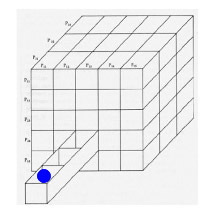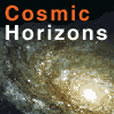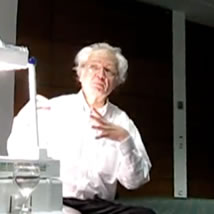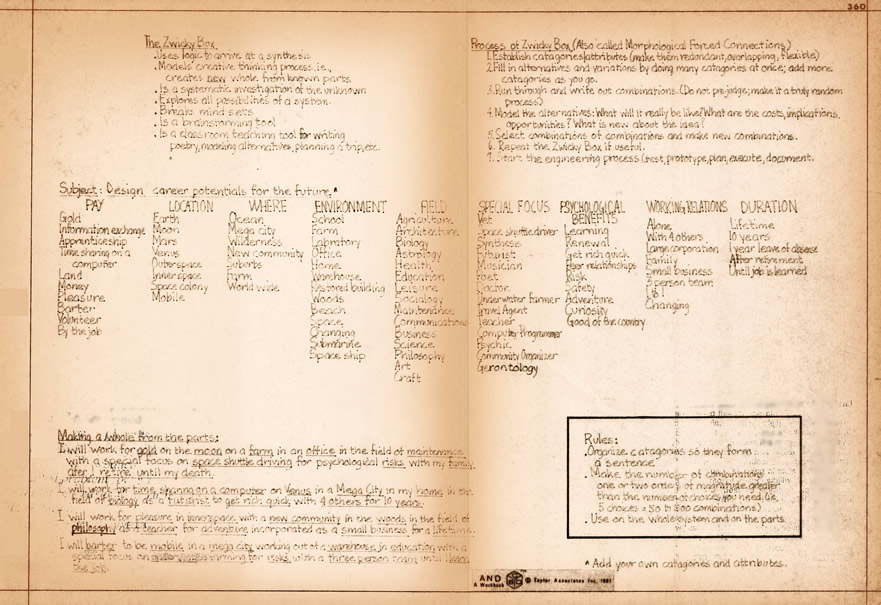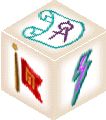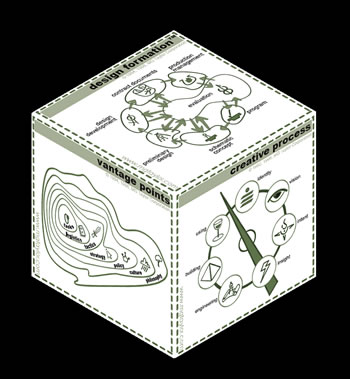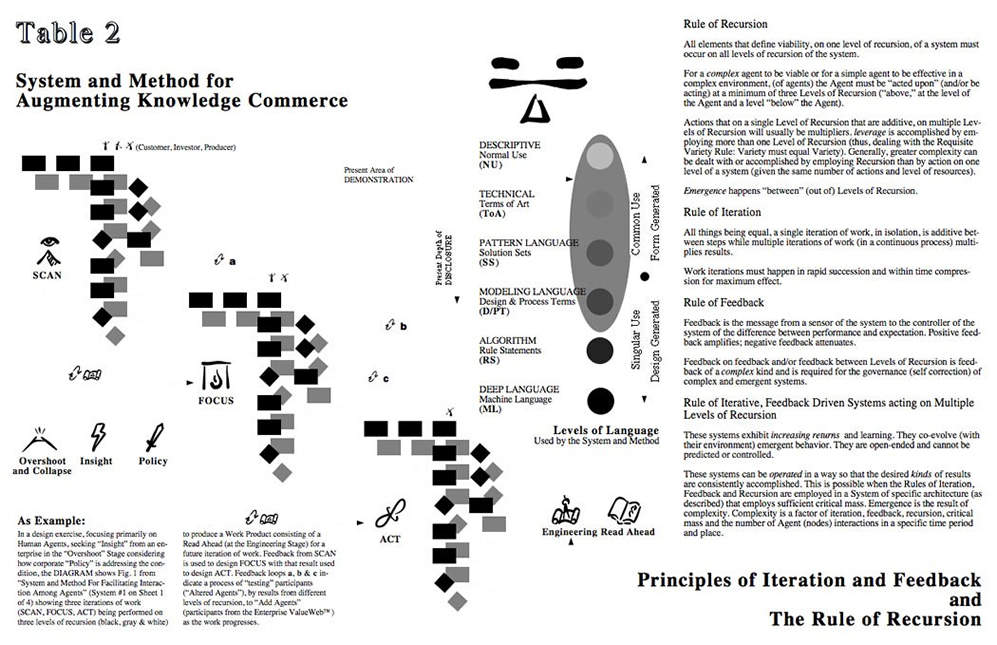| |
|
Insight
Strategy,
Contruction
Document |
key articles on:
Fritz Zwicky,
Zwicky Box, Morphological Analysis |
Robert Heinlein:
Time Enough for Love |
“Before me all invention was a matter of luck...” |
Zwicky Box examples on page 2 |
Zwicky Box examples from 1981 Solution Box Workshop |
Zwicky Box for use in science, engineering and design |
Zwicky Box for Weak Signal Research and Learning |
Zwicky Box for individual and group processes |
The process of iteration, recursion and feedback of a complex kind |
Relevant Taylor Method Models |
|
|
the History and pracice of the Zwicky Box
|
click on graphics above to view information relevant to the ZwickyBox |
| In 1973, the science fiction writer Robert Heinlein in Time Enough for Love wrote the following assuming that his readership would understand, without explanation, the casual reference to a Zwicky Box. Unfortunately, this most likely would not be the case today. Is one of the best design methods at risk of being forgotten? |
All right, when are you starting that research?” “I’ve already started it.” “But you said—No, you didn’t. Damn your impudence, boy. All right, what direction are you pushing it?” “All directions.” “Impossible. You don’t have that many people at your disposal, even assuming that all of them are capable—whereas the person capable of creative thought is less than one in a thousand.” “No argument. But what about the sort of person that you said was just like us—but magnified? Minerva is director of research on this, Lazarus. I talked it over with her; she’s setting it up. All directions. A Zwicky investigation.” “Hmm. Well . . yes. She could—I think she could. Whereas even Andy Libby might have found it difficult. How is she designing her morphological box?” “I don’t know. Shall we ask her?” “Only if she’s ready to be asked, Ira. People get annoyed when interrupted for progress reports. Even Andy Libby used to get irritable if anyone joggled his elbow.” “Even the great Libby probably didn’t have the time-share capacity Minerva has. Most brains are merely linear, and I’ve never heard of any human genius who had more than three tracks.” “Five…”
“…The preliminary matrix uses five dimensions, but with a certainty that auxiliary dimensions will be needed for some pigeonholes. That being noted, there are now nine by five by thirteen by eight by seventy-three—or three hundred forty-one thousand six hundred forty discrete category pockets before auxiliary expansions. For check, the original trinary readout is unit pair pair comma unit nil nil comma unit pair pair comma unit nil nil point nil. Shall I print out decimal and trinary expressions?”
“…Ira, you might ask Minerva to print it somewhere else before she wipes it. As a book. A big book, ten or fifteen volumes. You could call it ‘Varieties of Human Experience,’ by, uh, ‘Minerva Weatheral.’ It would be the sort of thing professors argue over for a thousand years. I’m not joking, Ira; it should be preserved, I think it’s new. It’s a job too big for flesh-and-blood, and I sort o’ doubt that a computer of Minerva’s caliber has ever before been asked to do this sort of Zwicky.” “Minerva, would you like that? Preserve your research notes and edit them into a book? Say a few hundred full-size bound copies in a handsome presentation format plus microperms for libraries on Secundus and elsewhere. For the Archives…”
EXCERPTS FROM
|
Time Enough for Love
Robert A. Heinlein
Category: Sci-Fi & Fantasy
82 Ratings
|
Robert A. Heinlein. “Time Enough for Love.” PENGUIN group, 2011-03-29. iBooks. This material may be protected by copyright. |
|
|
| It is notable that 40 years ago Heinlein, in an entertaining and often insightful way, explored many of the “what ifs” of the consequences of Humankind achieving what is today often refereed to in the social realm as Singularity. If you have been making plans for your future and have not put into your Zwicky Box many of the design assumptions of Singularity, I suggest your search algorithm may be deficient in many ways. |
| Fritz Zwicky built a tool for the systematic exploration of options within a defined system. This tool/process has proven to be of enormous consequence and benefit in science, technology and in many area of futurism and planning. In this paper, I will explore the traditional use of Morphological connections and also make the case that the tool can be equally as powerful and beneficial at the beginning of the creative process as it is during the scientific, engineering and design development development phases. |
| In the 60s I found this true with CPM and PERT methods. They were introduced as computer generated output tools for project management which they are certainly useful for. What was not seen is that this diagramming method is a great design tool when exploring options of how a project can be conducted long before the many details necessary for a project management output are known. Options that, if a conventional approach was assumed, the computer would never “see.” In the 70s, when I ran across “Discovery, Invention, Research Through the Morphological Approach” written by Fritz Zwicky in 1969, the same thing hit me: that Zwicky Box method was not only useful in the rigourous exploration of bounded subjects but also with the open ended discovery of options which hidden design assumptions would almost inevitably obscure from easy discovery. In fact, these two approaches are in reality one. They are just two ends of a continuum. Each require the same level of rigour. The only difference is in the exact way the “Box” is built. As work moves from concept to reality, the precision of the Box and its use increases. |
|
One of the greatest challenges of an enquiry or design is ensuring that the beginning design assumptions of the process cover the full scope of the opportunity. Of course, this is nearly impossible if the field in question is new. Even in a known domain it is difficult if the limits of the system are being pushed. |
| No matter the methods used, the most reliable way out of this dilemma is to practice multiple iterations of work, through the entire creative process, employing the full range of vantage points as are relevant (to your purpose) as each stage of design formation is completed. In doing so, is is critical to re-create both content and the use of tools/process at each junction along the way. To assist the quest for completeness, a level of recursion (scale) above and below the field-in-focus must also be an integral past of the exercise. For those familiar with the Taylor Modeling language, you know the above statement has referenced several of its key models and processes. The Solution Box is a Zwicky box of 7x7x7 cells each identifying a location in the process of an idea becoming something conceived, articulated, modeled, engineered made and used. |
| click on Solution Box Model for more |
|
|
| Fritz Zwicky made the remark “before me all invention was a matter of luck...” [This is a quote from memory as the book is in Nashville and I am at Elsewhere] which of course did not make many people happy. What he was saying is that he developed a process which provided a much greater certainty that all of the significant alternatives to a problem had been considered before the solution was determined. Fritz Zwicky did come up with a large number of discoveries and inventions. How much of this was the result of his genius and how much his method is a matter of conjecture. The is no doubt, however, that the Zwicky Box works. |
| During WWII Fritz Zwicky as charged to look into the several different projects which were developing the jet airplane for the United States. He immediately realized that none of them had started with a full investigation of all the various means by which energy, mechanics and materials could be combined to solve the problem. In our language, the teams were starting “in the middle of the problem.” No matter how brilliant the engineering it was possible that whole solution sets were being ignored. This turned out to be the case. Of six different projects, each independent of one another, none were employing possible design strategies that were already “known” to science yet never fully explored. In so far as I know this was the first demonstration the the Zwicky Box approach. I have done a great deal of work with the USAF and NASA and it is true to this day, as it is in almost all fields, that a large amount of work, while brilliant, is often eccentric and driven by the vision of one or a few and not necessarily systemic in approach. |
| It is critical not to kill insight in the creative process. The Human brain works on many levels and tracks most of which we are not aware of. It is possible to stifle this extraordinary property of the mind with “too much” data in the wrong form, at the wrong time. Yet, this issue is not an “either-or” one. A close look at the Solution Box shows that there are many modulations wherein different mental modalities and criteria of content veracity come into play. The Zwicky Box method can be employed in several of these but not all. It can be a successful brainstorming tool and an analytical tool as the work moves through Program, Schematic, Preliminary Design, Design Development, Contract Documents, Production Management and Use. The Zwicky Box method can be employed successfully by an individual, a team and even a large group and, with all these, as an ideation tool and as a highly technical analytical one. Each of these uses have their own specific process techniques. This combination of group size, modality and technical means is in itself an interesting “Box” to explore. Try it. You should, in a matter of minutes, come up with several dozen ways to use this tool. |
| Employing the Zwicky Box is to use a conceptual tool that can be used to generate more application opportunities and ways to use it. The processes, itself, is a discipline and way of using your innate mental skills. It quickly becomes a way of organizing and thinking - a creative habit. This habit is to start every enquiry with an enhanced understanding of the true size and many ramifications that a question or challenge presents. It forces awareness of hidden design assumption that close down the range of thinking way too early in the creative process. |
|
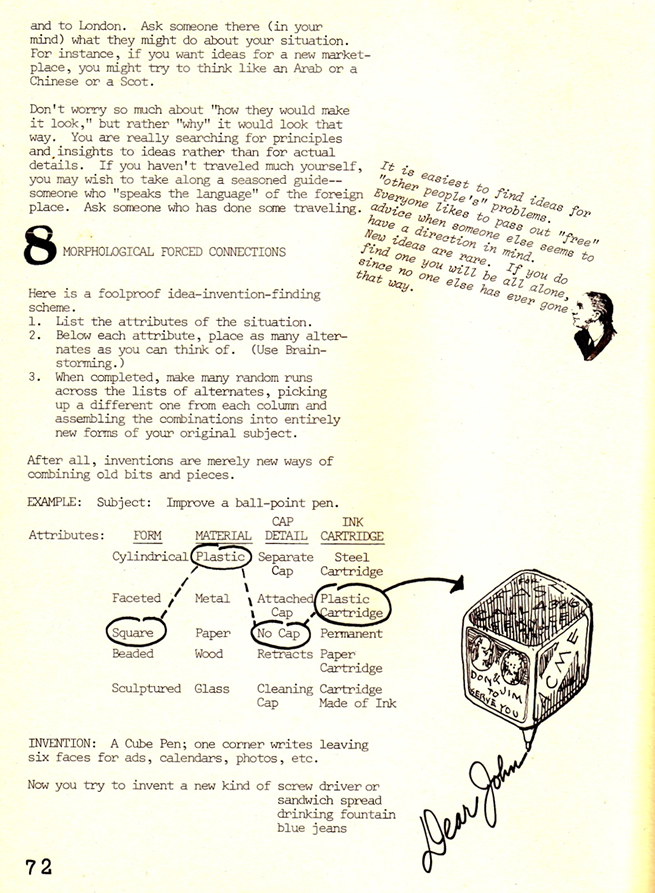 |
On the left is a short explanation of a simple us of Morphological Forced Connections from the classic manual on creativity, The Universal Traveler. Written in 1972 by Don Koberg and Jim Bangle, two professors from California Polytechnic State University School of Architecture and Environmental Design, this remains to this day one of the best and most accessible manual on creativity. Copies can still be found at Amazon. Get a pre 1977 copy. |
While Large scale multi dimensional Boxes are necessary for technological applications where all of the connections in a domain can be studied, the use of the technique in both a simple and complex form to “brainstorm” new combinations in fields both mature and not yet fully formed, is - properly employed - a useful technique. Koberg and Bangle provide a simple example on Page 72 of their book. |
What is interesting about this simple two dimensional matrix is with only 20 cells an idea which is highly unlikely can come from it. You can see that the 2d “plane” can become a “box” by adding more attributes on the “z” axis. As example in “Materials” what are the different kinds and forms of Plastic, Metal, Paper and so on. In a technical us of the Zwicky Box a system is defined and the all the known attributes of it are modeled in all their combinations. In uses like on the left and below, you are searching for the system which once found can be rigorously modeled. You can then take attributes of this result and begin searching again. Multiple iterations is the secrete use of this tool. |
I provide some of my personal Zwicky Box uses for design projects on page 2. |
|
| A Zwicky Box has by definition at last three dimensional. Large multidimensional Boxes require computers to sort thought all of the possible permutations. Yet, a two dimensional matrix can yield surprising results. Not only can this be useful, in itself, it provides a simple example of the power of the method when used in its most robust way. |
| On the right is a scan of a very simple matrix that Gail and I used to demonstrate the potential of the process in a our 1981 Constructing the Solution Box Workshop. With simple rules, this primitive form can still surprise. |
|
|
|
| 2d Zwicky Matrix Process: rules |
| Organize your Categories so that they form a sentence. |
| In this way, each set of combinations is a direct statement of a clear alternative. |
| Make the number of Combinations one or two orders of magnitude greater than you need. (i.e., 5 choices = 50 to 100 combinations) |
| The more the better, the not useful are easily culled, the unexpected may be gold. Even rejected ideas may have a piece of a great solution. |
| Use on the whole system and on the parts. |
| This is the use of iteration and recursion. After doing an iteration take the best options and build a box around them Scale a big idea down and a small on up. Take pieces and and combine then in new ways. |
|
| 2d Zwicky Matrix Process: steps |
| 1 - Establish categories/attributes (make them redundant, overlapping, flexible). |
| 2 - Fill in alternatives and variations by doing many categories at once; add more categories as you go. |
| 3 - Run through and write out combinations (do not pre-judge; make it a truly random process). |
| 4 - Model the alternatives: what will it really be like? What are the costs, implications, opportunities? What is new about the idea? |
| 5 - Select Combinations of combinations and make new combinations. |
| 6 - Repeat the Zwicky Box if useful. |
| 7 - Start the engineering process: test, prototype, plan, execute, document. |
|
| 2d Zwicky Matrix Subject: Career Potententials for the Future |
| PAY |
LOCATION |
WHERE |
ENVIRON-
MENT |
FIELD |
SPECIAL FOCUS |
PSYCHOLOG-
ICAL BENEFITS |
WORKING
RELATIONS |
DURATION |
| Gold |
Earth |
Ocean |
School |
Agriculture |
Vet |
Learning |
Alone |
Lifetime |
Information
exchange
|
Moon |
Mega City |
Farm |
Architecture |
Space Shuttle Driver |
Renewal |
With 4 others |
10 Years |
| Apprentice-ship |
Mars |
Wilderness |
Labratory |
Biology |
Synthesis |
Get rich quick |
Large Corporation |
1 year leave of absense |
| Time sharing on a computer |
Venus |
New Community |
Office |
Astrology |
Futurist |
Peer relationships |
Family |
After retirement |
| Land |
Outer Space |
Suburbs |
Home |
Health |
Musician |
risk |
Small
Business |
Until job is learned |
| Money |
Inner Space |
Farm |
Wharehouse |
Education |
Poet |
Safety |
3 person team |
|
| Pleasure |
Space Colony |
Worldwide |
Restored
Building
|
Leisure |
Doctor |
Adventure |
1 to 1 |
|
| Barter |
Mobile |
|
Woods |
Socialogy |
Underwarter farmer |
Curiosity |
Changing |
|
| Volunteer |
|
|
Beach |
Maintenance |
Travel agent |
Good for the economy |
|
|
| By the Job |
|
|
Space |
Communicat-ions |
Teacher |
|
|
|
| |
|
|
Changing |
Business |
Computer programmer |
|
|
|
| |
|
|
Submarine |
Science |
Psychic |
|
|
|
| |
|
|
Spaceship |
Philosophy |
Community organizer |
|
|
|
| |
|
|
|
Art |
Gerontology |
|
|
|
| |
|
|
|
Craft |
|
|
|
|
| |
|
|
|
|
|
|
|
|
|
| 2d Zwicky Matrix: Making a whole from the parts |
| I will work for gold on the Moon, on a farm, in an office, in the field of maintenance, with a special focus on space shuttle driving for psychological risk, with my family, after I retire, until my death. |
| I will work for time sharing on a computer on Venus in a mega City, in my home, in the field of biology, as a futurist, to get rich quick, with 4 others, for 10 years. |
| I will work for pleasure in inner space, with a new community in the woods in the field of philosophy, as a teacher, for adventure, incorporated as a small business, for a lifetime. |
| I will barter to be mobile in a mega city working out of a warehouse in education with a special focus on underwater farming, for risk, with a 3 person team, until I learn the job. |
|
| • Uses logic to arrive at synthesis |
| • Models creative thinking process, ie., creates new whole from known parts. |
| • Is a systematic investigation of the unknown. |
| • Explores all possibilities of a system. |
| • Is a brainstorming tool. |
| • Is a classroom teaching tool for writing poetry, modeling alternatives, planning a trip, etc. |
|
| THE ZWICKY BOX IN SCIENCE AND ENGINEERING |
| It is in these realms that the majority of documentation about the Zwicky Box and its use is to be found. This is fitting as this is where Fritz Zwicky mostly worked. I think however that he employed the method in the many areas outside of science and technology in which he had interest. Or, at least he thought that way as a habit. This thought raises a point about humans and tools. The relationship between the tool maker/user and the tool is reciprocal, a coevolutionary experience. I will take up on page 2 of this work. |
| All disciplines have a paradigm, a set of definitions and processes which are their basis for “truth” and how to know it. Science and engineering are no exception. At any moment in time, there is a system of models and facts considered as truth which is regarded by the practitioners as valid. This changes over time as more is learned. Often, competing theories or models exist at the same time each having superior utility in regards certain aspects of an art. For decades, as example, structural engineers did not have to worry too much about Quantum Mechanics yet electronic engineers did. This is changing as structures and their materials become more sophisticated. Competing theories can often provide unique ways of seeing something thus both can be useful even though “both can’t be right.” Science seeks to get it right. Engineering mixes theory with pragmatic knowledge to create things which work with minimal risk of failure. Design asks does this idea/information get me to what I want to achieve? |
| In general, as you move through the 7x7x7 matrix of the Solution Box, ideas, data, information becomes more selected, defined, tested and fixed. There is less “room” for alternatives. All options not fit for this project at this time have been eliminated. At the end of cycle of work or a project, it is essential to “open up” and resist taking the solution from one project and apply it as “truth” onto the next. As Henry Petroski points out, this “believing our numbers” syndrome is why we usually have one big technology melt down a generation. We are never as smart as we think. The Zwicky Box practice helps us to start over every time and challenge our assumptions, seek new information, avoid getting trapped in our expertize, find “solutions looking for problems,” and participate the full creative process not an isolated part. |
|
| THE ZWICKY BOX AS A DESIGN TOOL |
| There has been much talk in recent years about the “design economy” and, “design as the value add.” Yet design is still mostly treated in our society like a “thing” to do as an isolated process relatively unconnected to the whole of an organization and its primary functions. Design is an epistemology. It can be, and should be, applied as a major way of working/doing throughout all of life and work. The word “design” is from the French meaning “to mark out.” This alone points to the strong connection between the Zwicky Box and the design process. It also suggests that the Zwicky Box can have a major role in learning. This connection with design and learning is based on language. The Solution Box Model, is a 3d Matrix of words - definitions - which “mark out” the domains in focus and identify the criteria of their operation. A Zwicky Box is a matrix of language - be it in words, symbols or mathematical statements - marking out/putting boundaries around, a selected set of objects [the Taylor Method would call these “Agents”], at some determined degree of completeness and precision, in order to crate/define a system. The appropriate degree of completeness and precision is determined by the purpose of the exercise and what stage in the Solution Box Model the project is in. It is also effected by the application. A scientific paper or a bridge requires a greater degree of firm knowledge than a letter about a new idea or a piece of furniture. Misplaced over precision can be just as wrong as lack of it. This “marking out” is a primary creative act and it is the first step in Design Formation: “Program.” |
| The Zwicky process can be used at various way-points of the design process in conjunction with the 4 Step ReCreation Model to: audit the process to date, check for completeness, expand - in range and depth of detail - the field of focus of the work, recreate the problem by building a new Box based on the outputs of the last Zwicky Box and work cysle. This is the practice of iteration, recursion and feedback of a complex kind. |
| The Zwicky Box can be employed in the DesignShop process in many ways, here are a few: As a tool for designing simulations and scenario challenge exercises; as a participant exercise for framing the problem (as a first step in Creating the Problem) at the point of moving from Focus to Act; as a framework for team synthesis of their individual work from a Take-A-Panel module. A Zwicky Box exercise cam be useful in a Sponsor Session to enhance their sense of their challenge. |
|
| THE ZWICKY BOX AND WEAK SIGNAL RESEARCH |
| The process of Weak Signal Research is simple yet requires a disciplined and consistent practice. Employing the Zwicky Box greatly augments this practice. Here I will review the WSR process itself and then show how iterative use of the Zwicky Box in the step of active searching. In my page on Strong Memory I make the case that it is not passive; that, it actively seeks patterns of like-kind. A memory that is strong, is alert to examples similar to itself. This is like the difference between passive and active reading that Adler stresses in “How to read a Book.” It is also related to why the best way to learn a subject is to undertake the challenge to be innovative within its domain. |
| To do Weak Signal Research effectively, you have to be alert to patterns which are not yet fully in the broad awareness of your society. This requires much more than a rational search algorithm. It requires that your body/mind be “tuned” to pick up and distinguish certain signals much as an athlete trains for a game. Doing multiple Zwicky Box exercises not only stimulates the self-aware cognitive modes, it help to turn the whole body-mind into an effective organ of perception. This is accomplished even more effectively when the exercises are done as a group with aligned high energy. We often get comments after a DesignShop when participants have become aware of some new useful trends that “it is amazing how suddenly there is some much in the news about this.” It was there all along, but now the group is alert - and, perception is a factor in the morphogenic field. By definition, a “weak” signal becomes less weak as more people become aware of it and act upon this awareness. Our social experience is full of examples of the “sudden” emergence of issues that “come from nowhere” and “surprise” us often to our peril. We find out later that we were bombarded with Weak Signals about this “new” happening which we could not perceive/conceive. We had no model and framework in which to place the signal. |
| It is an axiom of the Weak Signal Process that if you find yourself totally shocked by a critical event out of nowhere that you should have a very serious conversation with yourself. You have failed an evolutionary fitness test. This is not a criticism in the usual sloppy social use of the word. It is a fact of reality. You were caught sleeping and this can be a loss of opportunity or a real threat. Innovators are those who were awake early to a weak signal and effectively acted upon it swiftly. The best way to “search the future” is to build models and “expect” things to happen at specific moments. If your Model(s) turn out to be “right” or “wrong” is not the immediate issue. Information is, as Gregory Bateson notes: “the difference that makes a difference.” An assumption found not useful is a gift. In time, if you stay with it, you will find the surprise and shock factor goes down and the value of your models go up. Zwicky, for fun and profit, your way to being requisite with the world you live in. And, remember: “the future is impossible to predict but it can be created.” |
|
| THE ZWICKY BOX AND LEARNING |
| One of the greatest mistakes often made in what commonly passes for education (“to lead out”), is to introduce knowledge as a conclusion instead as an understanding of how it was arrived at and ways that it is presently used. In a “knowledge economy” knowledge evolves rapidly. Often, in the desire to get the present knowledge understood by the student, the process used kills the ability of the student to be a discoverer and maker of knowledge. I argue that you do not know a subject if you can not be creative with it. A good Zwicky Box not only reveals new possibilities that are useful, it also brings to light those that are not (at least at a moment in time) commonly known and used. |
| In my work, I have to have a working knowledge of a large number of diverse fields. I learned long ago that there was a fast track to arriving at a basic level of competency in a new field of endeavour. This is the rule set: one, study the terms-of-art of the field; two, discover the arenas of controversy in the field; three, observe how the practitioners of the art resolve controversies; four, before you know too much, produce an original work in the field; five, repeat until you are comfortable; six, see if someone will hire you of buy what you created. In this process, the Zwicky Box is a wondrous tool. The terms-of-art are a language map of the terrain. The controversies show where the edges, and thus many possibilities, are. How controversy is handled is a reliable measure of the fields viability and near future. The ability to make a contribution is both a measure of what you bring and also of what you have learned. If you can be hired or if your product will sell, you have been judged competent by the market. As you do this, adding field to field, seek to discover the patterns that are common across them. This is where the gold is. |
| The relationship between the Zwicky Box and learning processes are reciprocal. It takes true knowledge to build a useful Zwicky Box, and, a comprehensive Zwicky Box will always offer the opportunity to learn. What makes the relationship between learning and design powerful, is the purpose and focus that a real world application brings. note how much pure science and innovation is accomplished in almost no time at all during a war. Much institutional learning in our society is standardized and attempts to teach without context as if there is such a thing as abstract knowledge independent of action. Research, design, engineering, making something, produces an entirely different search algorithm in the mind. It is deemed efficient to separate these skills and tasks on a large project yet when innovation is required a properly facilitated multidisciplinary team will win out every time. In the knowledge-based, design as a principle value add economy, learning and design no longer can be separated. Learning is creativity inward focussed with transformation of the mind as a goal. Design is creativity aimed outward with transformation of our world as a goal. One cannot take place without the other. The processes are essentially the same. There is a weight difference in the content and focus, that is all. |
|
| THE ZWICKY BOX AND GROUP PROCESSES |
| The Zwicky Box is an excellent group process tool if used in much the same way as is the group Scenario and Glass Bead Game Modules. The Zwicky Box process does have to be carefully facilitated until a group gets into an easy, yet rigorous flow of work. Remember, we are integrating in one process both analytical and synthetic thinking. These two modes rarely are experienced in a large group at the same time. It is relatively easy for an individual practiced in the art of design to quickly switch back and forth between these two ways of thinking yet not easy in a group not yet in sync to do so. Therefore, this is a module best done later in a process after a natural alignment of energy has taken place. |
| Just as individuals have mental blocks which prevent them from seeing/remembering certain subjects, so do groups. Observe carefully the “no, no” concepts of a group and the language that they avoid. These indicate the boundaries of their conceptual world. In an individual, this might be called repression. A carefully constructed Zwicky exercise can help a team experience and reevaluate these self imposed limits. This works because the making of the box is a simple logical exercise yet the combinations can be full of unanticipated surprises. The F-15 and 777 examples on page 2 illustrates this and the world of solutions seeing new conceptual territory opened up for teams working on extraordinary complex issues. |
|
| THE ZWICKY BOX AND INDIVIDUAL PROCESSES |
| I will provide examples on page 2 of my use of the Zwicky Box to create and solve organizational problems and to design buildings. In this section, I will provide some general notes about individual use. First, a simple rule. When generating options to a design challenge, provide two to three orders of magnitude more than what is readily apparent as available and necessary. In addition, look for solution possibilities outside of the field in question. Most creative efforts are starved for lack of variety at the very beginning of the venture. There is a natural tendency to want to make a problem “simple” so that it can be solved. This is a good outcome at the end of an exercise not so at the beginning. Be careful not the game the system. Don’t build the Zwicky Box with a specific end in mind. Build it “blank slate.” |
| Learning to build Zwicky Boxes in your mind is a good exercise and process habit when the need for options suddenly arrises in everyday life and work. You have mastered this technique when you can “see” the Box in your minds eye and pull out the drawers one by one and evaluate their utility and charm. This is particularly important at the beginning of the design process. It is a common habit to get “trapped” by a circumstance by the hidden design assumption that it already has within its domain all of the variety and resources necessary for a solution. This is rarely the case. The best design strategy is to add variety and explore the options carefully. It is easy to cut variety later. |
|
click on Table graphic to download a PDF of this Model |
| Table 2, from the Taylor Patent, our lines the principles of iteration, feedback and the rule of recursion of the Taylor System and Method. It also identifies the six level of language of the system. In this system, the Zwicky Box can be used as a tool to systematically organize the permutations of aspects inherent in a defined system and also a means to identify possible new systems. A Zwicky Box can be constructed in any of the 6 language level identified above as well as other languages not structurally inherent to the method yet which provide content. In Table 2 description of the Zwicky Box and it uses, the language levels employed are: Descriptive (NU), Technical (ToA), Pattern Language (SS) and Modeling Language (D/PT). Each of the languages have their strong and weak points in terms of revealing information about the Method and its language. It is wise to explore a system using multiple languages in order to get a sense of its larger dimensions. The Zwicky Box could be described, for example, on the language level of Algorithm (RS) which would be useful if you were building a Zwicky Box App. A Zwicky Box could be built with various levels, of this language as a means of achieving a richer output. This way of thinking/working explicitly uses language as a tool in both a self-aware and spontaneous way. It recognizes that each formal system of language is a lens viewing the world and also an active agency within the mind of the perceiver; and, that it is the interaction of both which creates new possibilities. |
|
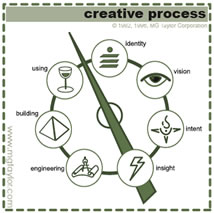 |
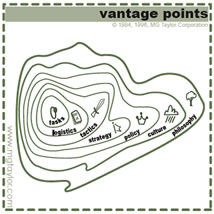 |
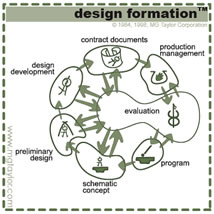 |
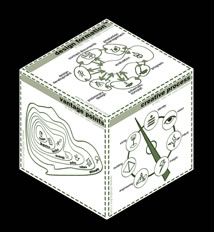 |
7 Stages of the Creative Process |
Vantage Points Model |
Design Formation Model |
Solution Box Model |
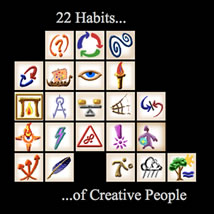 |
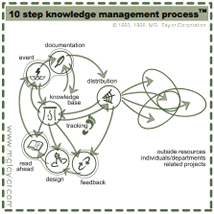 |
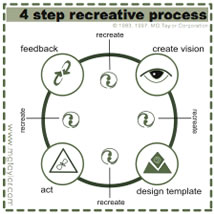 |
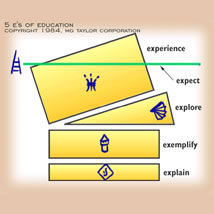 |
22 Creative Habits |
10 Step Process |
4 Step ReCreation Model |
5 Es of Education Model |
click on icons to go to details on these models |
posted:
August 30, 2013 • updated September 17, 2013 • 7:45 PM @ Elsewhere |
|
\\\\\\\\\
|
